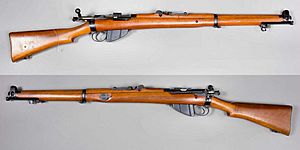Lee–Enfield facts for kids
Quick facts for kids Lee–Enfield |
|
|---|---|

Short Magazine Lee–Enfield Mk I (1903), Swedish Army Museum, Stockholm
|
|
| Type | Bolt-action rifle |
| Place of origin | United Kingdom |
| Service history | |
| In service |
|
| Used by | See Users |
| Wars |
List
Second Boer War
World War I Easter Rising Various colonial conflicts Polish-Soviet War Jallianwala Bagh Massacre Irish War of Independence Irish Civil War Constitutionalist Revolution(Limited) Spanish Civil War World War II Indonesian National Revolution Indo-Pakistani Wars Greek Civil War Malayan Emergency French Indochina War Korean War 1948 Arab–Israeli War Border Campaign (Irish Republican Army) Mau Mau Uprising Suez Crisis Algerian War Portuguese Colonial War Congo Crisis Battle of Mengo Hill Nathu La and Cho La clashes Nigerian Civil War Vietnam War Rhodesian Bush War Cypriot intercommunal violence The Troubles Sino-Indian War Dhofar Rebellion Zanzibar Revolution Chadian Civil War Bangladesh Liberation War Turkish invasion of Cyprus Uganda–Tanzania War Soviet–Afghan War Nepalese Civil War Afghanistan conflict Iraq War |
| Production history | |
| Designer | James Paris Lee, RSAF Enfield |
| Produced |
|
| No. built | 17,000,000+ |
| Variants | See Models/marks |
| Specifications | |
| Mass |
|
| Length |
|
| Barrel length |
|
|
|
|
| Cartridge | .303 Mk VII SAA Ball |
| Action | Bolt-action |
| Rate of fire | 20–30 aimed shots per minute |
| Muzzle velocity | 2,441 ft/s (744 m/s) |
| Effective firing range | 550 yd (503 m) |
| Maximum firing range | 3,000 yd (2,743 m) |
| Feed system | 10-round magazine, loaded with 5-round charger clips |
| Sights | Sliding ramp rear sights, fixed-post front sights, "dial" long-range volley; telescopic sights on sniper models. Fixed and adjustable aperture sights incorporated onto later variants |
The Lee–Enfield or Enfield is a bolt-action, magazine-fed repeating rifle that served as the main firearm of the military forces of the British Empire and Commonwealth during the first half of the 20th century, and was the British Army's standard rifle from its official adoption in 1895 until 1957. The WWI versions are often referred to as the "SMLE", which is short for the common "Short, Magazine, Lee–Enfield" variant.
A redesign of the Lee–Metford (adopted by the British Army in 1888), the Lee–Enfield superseded the earlier Martini–Henry, Martini–Enfield, and Lee-Metford rifles. It featured a ten-round box magazine which was loaded with the .303 British cartridge manually from the top, either one round at a time or by means of five-round chargers. The Lee–Enfield was the standard issue weapon to rifle companies of the British Army, colonial armies (such as India and parts of Africa), and other Commonwealth nations in both the First and Second World Wars (such as Australia, New Zealand, South Africa, and Canada). Although officially replaced in the United Kingdom with the L1A1 SLR in 1957, it remained in widespread British service until the early/mid-1960s and the 7.62 mm L42A1 sniper variant remained in service until the 1990s. As a standard-issue infantry rifle, it is still found in service in the armed forces of some Commonwealth nations, notably with the Bangladesh Police, which makes it the second longest-serving military bolt-action rifle still in official service, after the Mosin–Nagant (Mosin-Nagant receivers are used in the Finnish 7.62 Tkiv 85). Total production of all Lee–Enfields is estimated at over 17 million rifles.
The Lee–Enfield takes its name from the designer of the rifle's bolt system—James Paris Lee—and the location where its rifling design was created—the Royal Small Arms Factory in Enfield.

